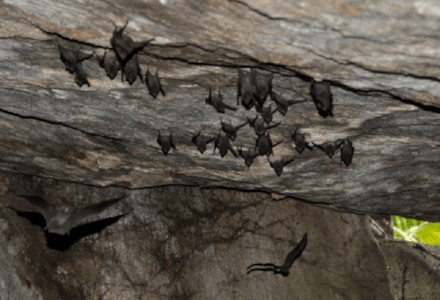
Photo Credit: Island Conservation Society
CC License: https://bit.ly/1GZ2EOO
Seychelles Sheath-Tailed Bat Facts
- Clearly, the distinctly fascinating, albeit comparatively small, Seychelles Sheath-Tailed Bat elegantly proves that physical size remains irrelevant. Sadly, the amazing animal also currently officially ranks as one of the rarest creatures known to science.
- Bats of all kinds, further classify as mammals placed within the Family Chiroptera. These truly remarkable creatures also hold a very special and distinct scientific status. The group still remains the only known mammals capable of true flight.
- Its common name also derives from a particularly unique physical characteristic of the tantalizing species. That’s because of the remarkable presence of a small membrane extending between the hind legs that can be placed over the tail.
- Most unfortunately, this extremely interesting species now only inhabits a severely restricted habitat range. Its original range, though, still remains undetermined. This lamentable statistic makes the fascinating animal extremely vulnerable.
- In the modern era, the greatest threats to the continued existence of the Seychelles Sheath-Tailed Bat as a species appear to be comprised of three factors. First comes continued loss of habitat to the planting of coconut plantations.
- Next is the presence in its range of invasive species. Finally, however, would be climate change. Experts place its numbers at fewer than 100 remaining individuals. The IUCN appropriately currently lists the harassed creature as Critically Endangered.
Related Articles
Pallid Bat Honduran White Bat Malaysian Flying Fox
Seychelles Sheath-Tailed Bat Physical Description
Uniquely, the extremely rare and highly threatened Seychelles Sheath-Tailed Bat stands out for several reasons. Some of them include factors other than sheer size. That holds true since the animal evolved as a comparatively diminutive member of its order.
In point of fact, an average head and body length for this specific species remains slight. This actually only totals between 2.1 – 2.5 in (55 – 65 mm). This tiny yet impressive mammal does share one particular characteristic with many of its related species, however.
This occurs given that fact that the mammal displays a slight degree of the trait of sexual dimorphism. In its case, though, this occurs in the species in regards to weight. Males typically weigh about 10% less than the slightly thick-bodied females.
The fantastic Seychelles Sheath-Tailed Bat displays a dramatic pattern. This pattern consists of a deep reddish-brown to almost black, that predominates on the wings and back of the body. The underside of the body presents shades of gray or lighter shades of brown.
- Kingdom: Animalia
- Phylum: Chordata
- Class: Mammalia
- Order: Chiroptera
- Family: Emballonuridae
- Genus: Coleura
- Species: C. seychellensis
Photo Credit: Island Conservation Society
CC License: https://bit.ly/1GZ2EOO
Seychelles Sheath-Tailed Bat Distribution, Habitat, and Ecology
Lamentably, the seriously imperiled Seychelles Sheath-Tailed Bat has potentially lost much of its original range. It now exists only in a tiny part of the world. More precisely, this consists of the Seychelles Islands, north of Madagascar in the Indian Ocean, near Africa.
Many scientists theorize that it also once existed in great numbers in the region. Now, however, it apparently only exists in a few limited locations, with specific conditions. This species also generally roosts in small caves and the cracks and crevices of rock faces.
It additionally differs from most types of bats in a striking manner. The great majority of bats typically roost in enormous groupings. This animal, however, forms harem colonies. These generally comprise a total of only 1 or 2 males, with multiple females.
Quite sadly, even more than most other endangered species, it appears to be especially vulnerable to habitat deterioration due to the influx of non-native plant species. This occurs since many of the native insect species cannot feed upon these invasive species of plants.
Its own numbers have therefore greatly decreased. This, in turn, has the obvious effect of significantly reducing the available food source for the Seychelles Sheath-Tailed Bat. But this affects it more than others since the species has an entirely insectivorous diet.
Species Sharing Its Range
Rosy Periwinkle Kalanchoe Comet Moth
Check out our other articles on 7 Supremely Scintillating Cnidaria, Victoria Crowned Pigeon, Saint Francis’ Satyr Butterfly, Long-Finned Pilot Whale, Vietnamese Mossy Frog

